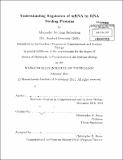Understanding regulation of mRNA by RNA binding proteins
Author(s)
Robertson, Alexander De Jong
DownloadFull printable version (12.79Mb)
Alternative title
Understanding regulation of Messenge Ribonucleic acid by Ribonucleic acid binding proteins
Other Contributors
Massachusetts Institute of Technology. Computational and Systems Biology Program.
Advisor
Christopher B. Burge.
Terms of use
Metadata
Show full item recordAbstract
Posttranscriptional regulation of mRNA by RNA-binding proteins plays key roles in regulating the transcriptome over the course of development, between tissues and in disease states. The specific interactions between mRNA and protein are controlled by the proteins' inherent affinities for different RNA sequences as well as other features such as translation and RNA structure which affect the accessibility of mRNA. The stabilities of mRNA transcripts are regulated by nonsense-mediated mRNA decay (NMD), a quality control degradation pathway. In this thesis, I present a novel method for high throughput characterization of the binding affinities of proteins for mRNA sequences and an integrative analysis of NMD using deep sequencing data. This thesis describes RNA Bind-n-Seq (RBNS), which comprehensively characterizes the sequence and structural specificity of RNA binding proteins (RBPs), and application to the developmentally-regulated splicing factors RBFOX2, MBNL1 and CELF1/CUGBP1. For each factor, the canonical motifs are recovered as well as additional near-optimal binding motifs. RNA secondary structure inhibits binding of RBFOX2 and CELF1, while MBNL1 favors unpaired Us but tolerates C/G pairing in UGC-containing motifs. In a project investigating how NMD shapes the embryonic transcriptome, this thesis presents integrated genome-wide analyses of UPF1 binding locations, NMD-regulated gene expression, and translation in murine embryonic stem cells (mESCs). Over 200 direct UPF1 binding targets are identified using crosslinking/immunoprecipitation-sequencing (CLIP-seq). Results from ribosome foot printing show that actively translated upstream open reading frames (uORFs) are enriched in transcription factor mRNAs and predict mRNA repression by NMD, while poorly translated mRNAs escape repression.
Description
Thesis: Ph. D., Massachusetts Institute of Technology, Computational and Systems Biology Program, 2014. Cataloged from PDF version of thesis. Includes bibliographical references (pages 167-187).
Date issued
2014Department
Massachusetts Institute of Technology. Computational and Systems Biology ProgramPublisher
Massachusetts Institute of Technology
Keywords
Computational and Systems Biology Program.